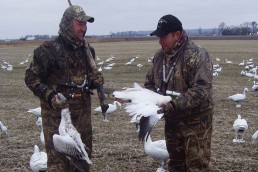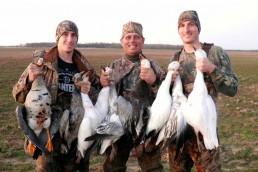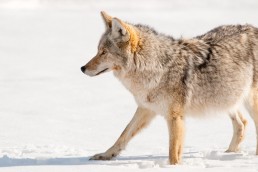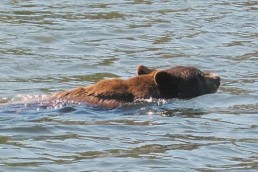Waterfowl Season Never Ends
SHARE THIS POST
For waterfowl hunters, it seems the season never ends. The actual shooting begins in September with the early Canada goose and teal seasons and then continues through the end of March when the light goose conservation season closes. Now is the time to get the duck boat back into top-notch shape.
First, shovel the mud, reeds, spent shells, cigar butts, pop cans and plastic wrappers out of the craft. Wash it down with clean water, for a change. Check the date on the fire extinguisher and get it recharged, if necessary. See if the PFDs are functional, check your air horn and make sure bow and stern lights are operational. Inspect the tail and running lights on the trailer and then grease the wheel bearings while you’re at it. Check your state boat registration and license plates to make sure they are current.
Let’s take a look at the motor. When that first hunting day comes along, you want to be certain the engine will turn right over and not leave you exhausted from pulling the starting rope. Run the motor for a few minutes. Did it start with only a pull or two? Did it run smoothly and not choke out after a few seconds? Do you feel it could keep running properly at higher RPMs? If not, a tune up is needed. If it passed those tests, change the oil and oil filter, and replace the lower unit lubricant, if needed. Then disconnect the fuel line and run the engine until it stops, thus eliminating the possibility of old fuel gumming up the lines. Now you can go fishing, but there are still a couple of things you want to get in order.
If you plan to hunt on public land you’ll have to apply in some form of lottery drawing for a blind site. Depending on which public site you choose, this can be done either through the mail, by email or at a public drawing. For most IDNR waterfowl-hunting properties, daily permits are issued through computer lotteries entered through emailed applications. These drawings are held on a predetermined date, and if you apply late, you’re out of luck. You can get this information by simply going to the DNR website where you will find full details as well as an application form that can be filled out and emailed back.
Are you enjoying this post?
You can be among the first to get the latest info on where to go, what to use and how to use it!
For most hunting sites administered by U.S. Fish and Wildlife Service, blind sites are awarded on an annual basis and require applicants to be present when the drawings are held. The information on these public drawings is readily available at the FWS website. Be aware that many hunters team up to attend these drawings, thereby increasing their chances of obtaining one or more blinds for the season for their group. If you want to organize your own group, plan now as most FWS drawings are held in late July and the blinds must be established before the hunting season.
Not all waterfowl hunters are computer-literate individuals, but in today’s world you are simply falling out of the loop. All state and government agencies are relying more and more on the internet to service their “constituents,” so it has become very difficult, if not impossible, to access them otherwise. If you can’t use a computer, my best advice is to ask someone with that ability to help you out.
Well, although you thought the time would never come, you have taken care of all your offseason waterfowl duties. Now you can now go fishing with a clear conscience. But hurry up and get it done while you can.
MWO
SHARE THIS POST
Did you enjoy this post?
You can be among the first to get the latest info on where to go, what to use and how to use it!
Jerry Pabst
Jerry Pabst has been writing about the outdoors for over 40 years. He captained a Lake Michigan charter boat for 25 years and was inducted into the Fresh Water Fishing Hall of Fame. He has hunted waterfowl in all North American flyways, pursued upland game extensively, and trains his own dogs.



